TSA Weekly: March 2 - 6, 2009


- Evolution Used to Aid Wisconsin Passenger
- TSA Employs ENGAGE! to Clear Passenger at Checkpoint
- A Message from Gale
The Hudson Connection: Training for the Critical Moment - In the FSD's Own Words
News
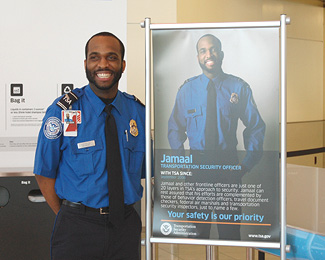
Large-scale photos of officers at their home airports, like the one pictured above, highlight their commitment to the traveling public's safety. Some signs also include personal stories about why the officer chose to work at TSA. These new signs are featured at several airports, including Los Angeles International, McCarran International (Las Vegas), Detroit Metropolitan Wayne County, Washington Dulles International, Denver International, Miami International, Baltimore/Washington International Thurgood Marshall (BWI) and Dallas/Fort Worth International. Pictured is Lead TSO Jamaal Carrington beside his poster at BWI. Photo by Lauren Gaches

Evolution Used to Aid Wisconsin Passenger
By Rich Pater, Evolution Jump Team, Outagamie County Airport
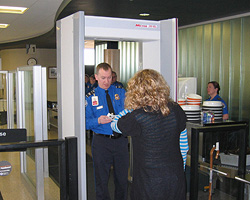
TSO Greg Koentopp assists a passenger. Photo courtesy of TSA Outagamie
TSO Greg Koentopp was working a walk-through metal detector at Outagamie County Airport in Appleton, Wis., when he noticed something different about the male passenger coming toward him.
Like at other airports that have completed ENGAGE! and COACH! training, stories about instincts and networks being used for greater success are coming to light at Outagamie County, and Koentopp was about to create one of those stories.
The man walked through the metal detector, then leaned against it. "He had a thousand-mile stare," said Koentopp. "Something was wrong."
The passenger's eyes were glassy and he appeared incoherent, then said he was dizzy. Koentopp, a trained first responder, reached out to his teammates, TSO Lisa Reetz and Lead TSO Diane Burzynski. They coordinated their efforts, called for medical help, and the man was successfully transported to a hospital.
It was a textbook case of See-Feel-Think-Do. "Evolution training helped me to use skills to carry through when it mattered most," said Koentopp.
"TSO Koentopp acted on instinct," said Transportation Security Manager Terry Murphy. "He trusted his gut, his experience, and the experience of others on his team to resolve the situation."
TSA Employs ENGAGE! to Clear Passenger at Checkpoint
By Mel Carson, customer support and quality improvement manager, Newport News/Williamsburg International Airport
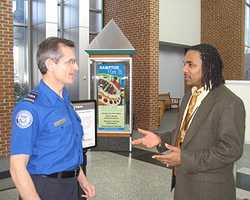
ICMS Coordinator Johnathan Wilkes (right) talks with Lead TSO Lance Horejs. Photo by Wilsantis Johnson
Integrated Conflict Management System Coordinator Johnathan Wilkes of Newport News/Williamsburg (Va.) International Airport applied principles of ENGAGE! at the checkpoint when he saw a female passenger wearing a bulging T-shirt.
When she walked through the metal detector, it "looked almost as though she was carrying a square pillow or a book under her shirt," said Wilkes. He alerted checkpoint Supervisory TSO Wilsantis Johnson, who directed a female officer, TSO Kristi Duff, to perform additional screening.
After discovering that the passenger was wearing several layers of clothing, she was given the opportunity to remove some of the garments in a private screening room.
Duff, assisted by Lead TSO Shonica Bell, observed that the woman was wearing approximately 30 bras and T-shirts. The woman explained that her group was on its way home from the Presidential Inauguration and some of them had worn additional underclothing against the cold weather in Washington, D.C.
"We were able to clear the passenger by using ENGAGE! as a tool between officers and with the passenger," said Wilkes. "This is the ideal way that teamwork resolves problems and mitigates the threat at the checkpoint."
A Message from Gale
The Hudson Connection: Training for the Critical Moment
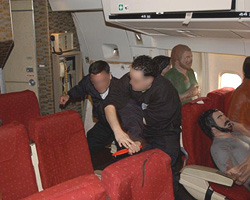
Federal air marshals participate in a training session. Photo courtesy of FAMS
We were all riveted by what happened.
US Airways Flight 1549 crash-landed into the freezing waters of the Hudson River after both engines were disabled, forcing the pilot to make instantaneous decisions that would determine the fate of the 155 people on board. As we now know, Captain Sullenberger navigated the plane to an emergency water landing and everyone on board survived.
Captain Sullenberger used his experience and gut instincts to make critical life or death decisions and then took action, saving lives. His performance in those critical moments – less than three minutes – was nothing less than heroic. But he was only able to do what he did because of his experience and training.
As a former Air Force pilot and long-time commercial airline pilot, Sullenberger was subject to constant drills and testing – everything from "proficiency checks" in the simulator and aeromedical exams every six months to random checks by the FAA, which could choose to observe him from the jumpseat in the cockpit at any time. He was ready at the critical moment because he had the calm and confidence that only constant testing and training could give him.
As I read about this incident in the media, I thought of TSA's frontline workforce – our TSOs and FAMs. Like commercial pilots, you are also subject to constant testing and training to keep your skills honed. In fact, you are the most tested, drilled, and scrutinized workforce in the federal government.
Working on the frontline, being alert at all times, and interacting with close to 2 million passengers a day, is not an easy job. I know that with these tests and drills comes pressure to succeed. But I also know that the tests, in addition to your on-the-job experiences, make you ready for any challenge you might face.
Let's not forget that while Captain Sullenberger didn't set out to become a hero, at that fateful moment he made the right decisions because he was ready and he had confidence in his abilities. Similarly, as you approach your job every day, engage, exude the confidence and calm gained from your experience and training. You are ready and we are grateful.

Evolution: In the FSD's Own Words
Evolution is a means to stay focused and use your training and experience to determine what is not right, and to act on your instincts. – FSD Derek DePietro, Buffalo Niagara (N.Y.) International Airport
Engage the Evolution team with your questions and suggestions at ENGAGEevolution@dhs.gov.
News
TSNM is All About Partnerships
By Jason Lim, program analyst, Office of the Deputy Administrator
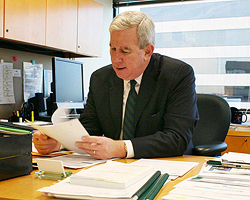
Assistant Administrator John Sammon, Transportation Sector Network Management. Photo by Andy Szul
Transportation Sector Network Management (TSNM) remains a mystery to many at TSA. Even John Sammon, TSNM's assistant administrator, admits that it takes some explaining for people to understand what transportation security has to do with network management.
"We could just as easily call the office, ‘stakeholder engagement,'" Sammon explained, "since that's what we actually do. We reach out to our various stakeholders and lead a collaborative effort to develop and implement security plans that are operational. It's about working together to achieve the security mission."
And who are these stakeholders?
They are key law enforcement agencies like the N.Y. Police Department and the L.A. Sheriff's Department. They are Amtrak and Metro; Southwest Airlines and UPS. They are the pilots, conductors, commercial drivers, cargo shippers, insurance underwriters and private security companies. They are the people who run the different modes of transportation: aviation, rail, mass transit, maritime, pipelines, highways and air cargo. In fact, TSNM was created out of the realization that transportation in America is actually a network of these different modes of transportation, with multiple operators who have to run them on a daily basis.
"With the important exception of in-flight security through our FAMs [federal air marshals] and checkpoint and passenger baggage security by our TSOs, most transportation security is not provided by TSA," Sammon said. "Everyday security is provided by the operators of these various modes. So our job at TSNM is to actively engage these network stakeholders to work together to put operationally effective security measures in place that will work day in and day out."
Engaging with stakeholders from the beginning pays huge dividends. For example, by working with our industry partners early, TSA met the Feb. 3 deadline to screen 50 percent of commercial passenger aircraft cargo with a solution that achieved the goal while minimizing disruptions to the flow of commerce.
"We don't want to be a government agency that just hands down regulations and policies to industries and then assumes the job is done," Sammon emphasized. "We want to lead the whole process by engaging and including key players at every step of the way."
The key to engaging this transportation network is the team of knowledgeable, committed individuals TSNM has assembled. "You can't lead without the subject matter experts who know their industries, are committed to the mission of TSA, and will work tirelessly to make it happen," Sammon said. "I can't emphasize enough how indebted I am to the GMs [general managers] and their staffs who have taken charge of their respective modes of transportation and created a cohesive team that cuts across all the different players involved. It's a truly monumental effort. Our people are our greatest achievement to date. Personally, working with them is an inspiration every day."
Sammons' message to his team has remained consistent: Great job; let's remain focused with a clear sense of the mission; and keep the pedal to the metal. "When Kip and Gale first asked me to take charge of TSNM, they told me it would be the hardest job I'd ever have – and they were absolutely right," Sammons recalled with a laugh, referring to former Administrator Kip Hawley and Acting Administrator Gale Rossides. "But they also knew it would be the most rewarding job ever. They let me find that out for myself."
TSA Iowa Gets Refresher on Fraudulent Document Detection
By Lindsey Pantzlaff, master TSO, Des Moines International

Des Moines' Pat Harrigan, assistant FSD-law enforcement, addresses TSA Iowa staff at the documents workshop. Photo by Paul Herrera
TSA Iowa recently partnered with Immigration and Customs Enforcement (ICE) to provide TSA officers, inspectors and staff additional training on key methods for detecting fraudulent documents.
The workshop was led by members of the ICE Forensic Document Laboratory, whose mission is the detection and deterrence of travel and ID fraud.
"The training was an opportunity to meet, interact and learn from members of another agency within the Department of Homeland Security," said Des Moines Assistant FSD-Law Enforcement Pat Harrigan, who arranged for the training. He said working with ICE augments training that officers and other TSA employees receive.
Virginia Stout, a behavior detection officer from Cedar Rapids, said she "was very happy to be part of the class. We can all benefit every day from this presentation." Lead TSO Jason Channon, Des Moines, said he found the session "very useful. I think this training will give our TSA workforce the ability to do an even more effective job in finding fraudulent documents."
"By teaming up and coordinating resources with an agency like ICE, we strengthen our network of resources and contacts to enhance our many layers of security," said Des Moines FSD Jay Brainard.
TSA Providence Conducts 50th VIPR Operation
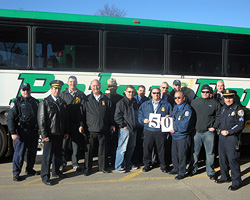 Representatives from local, state and federal agencies (pictured) joined TSA Providence, R.I., to support a Visible Intermodal Prevention and Response (VIPR) operation at the city's Peter Pan Bus Terminal on Feb. 13. The operation represented two milestones for the Rhode Island team: It was the first VIPR conducted at a Rhode Island bus terminal and it marked the 50th VIPR operation for TSA Providence led by Federal Security Director Joe Salter. Over the past three years in Rhode Island, TSA, the Federal Air Marshal Service, FBI, state police, state Fire Marshal's Office and the Providence police Homeland Security Division have routinely joined forces to hold VIPRs throughout the state. Venues have included the passenger rail and mass transit train stations, ferries and ferry terminals, the airport and Newport's cruise ship terminal. "The cooperation between federal, state, local agencies and industry partners has been exceptional in Rhode Island and enabled us to reach this great milestone," said Salter.
Representatives from local, state and federal agencies (pictured) joined TSA Providence, R.I., to support a Visible Intermodal Prevention and Response (VIPR) operation at the city's Peter Pan Bus Terminal on Feb. 13. The operation represented two milestones for the Rhode Island team: It was the first VIPR conducted at a Rhode Island bus terminal and it marked the 50th VIPR operation for TSA Providence led by Federal Security Director Joe Salter. Over the past three years in Rhode Island, TSA, the Federal Air Marshal Service, FBI, state police, state Fire Marshal's Office and the Providence police Homeland Security Division have routinely joined forces to hold VIPRs throughout the state. Venues have included the passenger rail and mass transit train stations, ferries and ferry terminals, the airport and Newport's cruise ship terminal. "The cooperation between federal, state, local agencies and industry partners has been exceptional in Rhode Island and enabled us to reach this great milestone," said Salter.
In Tribute
(Names of TSA employees and dates of death provided by the Office of Human Capital)
- Kenneth Dunnum, Supervisory Program Analyst, Office of Security Operations, headquarters (Arlington, Va.), Feb. 15, 2009
- John Sharp, Lead TSO, Amarillo (Texas) International Airport, Jan. 30, 2009
- Meredith Moore, TSO, Little Rock (Ark.) National Airport, Jan. 29, 2009
- Jamie Morgan, TSO, Ft. Lauderdale-Hollywood (Fla.) International Airport, Jan. 25, 2009
- Michael Ellis, TSO, Minneapolis-St. Paul International Airport, Jan. 17, 2009
- Justin Wujcik, TSO, Logan (Boston) International Airport, Jan. 16, 2009
- Raul R. Cruz Jr., TSO, Denver International Airport, Jan. 14, 2009
- Charles Mitts, Federal Air Marshal, Houston, Jan. 14, 2009
- Dennis Brogan, Federal Air Marshal, Los Angeles, Jan. 9, 2009
- Gretchen Garrett, TSO, Dallas/Fort Worth International Airport, Dec. 13, 2008
Kudos & Clips
The Weird & Wacky Stuff Confiscated at New York Customs ...
By Lauren Johnston, New York Daily News, March 2, 2009
Attention, airline passengers: Leave the chain saws, chocolate-covered heroin bars and frozen monkey heads at home. Read more. (NYDailyNews.com)
Pilot Program Tests Millimeter Wave for Primary Passenger Screening
From the TSA Evolution of Security blog, Feb. 20, 2009
This week, TSA began testing MMW technology in the place of a metal detector at Tulsa International Airport to assess passenger throughput and acceptance. Read more. (TSA blog)
TSO Sheretta Stewart was the most helpful TSA employee I have ever encountered. I was traveling with my daughter, who was in a wheelchair. TSO Stewart took charge of her, helped her go through security screening and retrieved her personal items from the conveyor belt. She then put my daughter's shoes on and made sure she had everything. TSO Stewart smiled, joked and laughed the entire time. She made what can be a stressful experience a very pleasant one.
Natalie Haley, Troutville, Va., to Gloria Campbell, customer support and quality improvement manager, Southwest Florida International Airport, Fort Myers. Feb 7, 2009.
TSA Experience
Officer's Engagement Leads to Illegal Drug Discovery
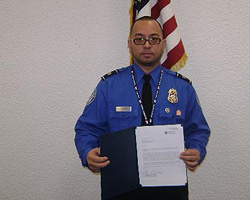
Photo by Gary T. Smith
Miami TSO Danilo Hoffman (pictured) was recognized with an Eagle Eye pin for discovering illegal drugs that a passenger allegedly attempted to hide during screening. After initially resisting, the passenger produced two plastic bags, one of which contained a greenish brown organic substance that police later confirmed was marijuana. "By receiving this pin, the officer has proven himself to be an exceptional member of the TSA team, bringing credit to both himself and the agency," said Transportation Security Manager James Vazquez.
More TSA Experiences
- IdeaFactory Hosts Detailee Challenge Winner
- Officers Get Creative With Gnome Character
- TSA Honor Guard Thanked by Spectators
- War Hero Visits Airport
E-mail your comments and suggestions.



